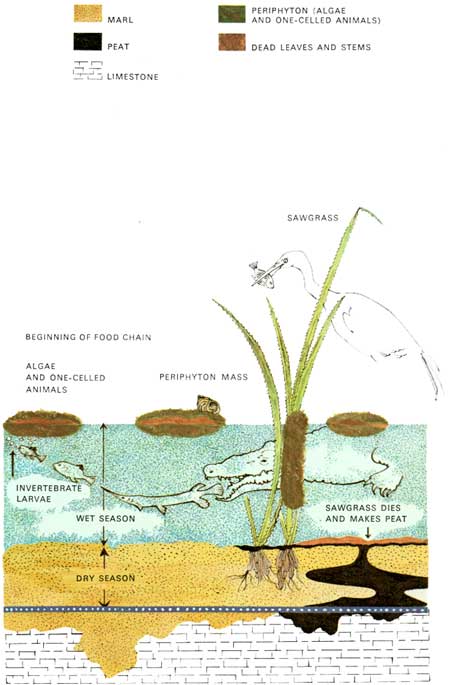|
EVERGLADES National Park |
 |
PLANT-AND-ANIMAL COMMUNITIES (continued)
Web of Life in the Marsh
Around the stems and other underwater parts of the glades plants are cylindrical masses of yellowish-green periphyton. So incredibly abundant are these masses of living material that in late summer the water appears as though clogged with mossy-looking sausages and floating pancakes. Largely algae, but containing perhaps 100 different organisms, the periphyton supports a complex web of glades life. It is the beginning of many food chains in the fresh-water marsh. The larvae of mosquitoes and other invertebrates, larval frogs (tadpoles) and salamanders, and other small, free-swimming creatures feed upon the tiny plants and minute animals living in the masses of periphyton. These periphyton feeders are in turn fed upon by small fish, frogs, and other vertebrates, which are food for big fish, birds, mammals, and reptiles; most of these larger creatures are preyed upon by the alligator.
The periphyton is perhaps most important for its role in maintaining the physical environment of the marsh. The water flowing over the limestone of the glades is hard with calcium. The algae remove this calcium and convert it to marl (see glossary), which precipitates to the bottom. Sawgrass is rooted in this marl; accumulated dead sawgrass forms peat; other marsh plants, including willows and the trees of the bayheads, spring up from the peat. Acid from the peat and from decaying plant matter of the tree islands dissolves some of the marl and underlying bedrock—and the cycle is complete.
 WEB OF LIFE IN THE MARSH. (click on image for an enlargement in a new window) |
Every plant, every animal, every physical element is involved in this web of life—as soil builder, predator, plant-eater, scavenger, agent of decay, or converter of energy and raw materials into food. Damage to or removal of any of these components—pollution of the water, lowering of the water table, elimination of a predator, or any interference in the energy cycle—could destroy the glades as we know them.
Every other plant-and-animal community in the park—hammock, mangrove swamp, pineland, etc.—is an association of large and small organisms sharing a physical environment. It is impossible to understand either the park as a whole or the life of a single creature without being aware of these interrelationships.

|

|
|
|
|
Last Modified: Sat, Nov 4 2006 10:00:00 pm PST |


